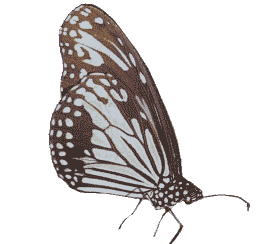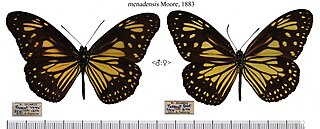
Parantica, commonly called tigers, is an Old World genus of butterflies in subfamily Danainae of family Nymphalidae. They are found in southeastern Asia, Indonesia, Papua-New Guinea, and the Philippines. Many of these species are endemic to islands and considered endangered, vulnerable, or threatened according to the IUCN Red List. For other butterflies called tigers see the genus Danaus.

Zinken's tiger is a species of nymphalid butterfly, endemic to Indonesia.

The New Ireland yellow tiger is a species of nymphalid butterfly in the subfamily Danainae. It is endemic to the island of New Ireland.

Crowley's tiger is a species of nymphalid butterfly in the Danainae subfamily. It is found in Brunei, Indonesia, and Malaysia.
The D'Abrera's tiger is a species of nymphalid butterfly in the Danainae subfamily. It is endemic to Sulawesi, Indonesia. The species was discovered by Bernard d'Abrera, an Australian entomological taxonomist and philosopher of science. The butterfly is described as black and white, with similar markings to a monarch butterfly.
The David's tiger is a species of nymphalid butterfly in the Danainae subfamily. It is endemic to the Philippines.

The Kirby's tiger is a species of nymphalid butterfly in the Danainae subfamily. It is found in Indonesia and Papua New Guinea.
Kuekenthal's yellow tiger is a species of nymphalid butterfly in the Danainae subfamily. It is endemic to Indonesia.

The Biak tiger is a species of nymphalid butterfly in the Danainae subfamily. It is endemic to Biak in Indonesia.

The Manado yellow tiger is a species of nymphalid butterfly in the Danainae subfamily. It is endemic to Sulawesi, Indonesia.
The Milagros' tiger is a species of nymphalid butterfly in the Danainae subfamily. It is endemic to the Philippines.

The Sumbawa tiger is a species of nymphalid butterfly in the Danainae family. It is endemic to Indonesia.

The Felder's tiger is a species of nymphalid butterfly in the Danainae subfamily. It is endemic to the Philippines.

The fat tiger is a species of nymphalid butterfly in the Danainae subfamily. It is endemic to Papua New Guinea.
Father Schoenig's chocolate is a species of nymphalid butterfly, endemic to the Philippines.

The Bonthain tiger is a species of nymphalid butterfly in the Danainae subfamily. It is endemic to Sulawesi, Indonesia.

The Ceylon tiger is a species of nymphalid butterfly in the Danainae subfamily. It is endemic to Sri Lanka.

The Timor yellow tiger is a species of nymphalid butterfly in the subfamily Danainae. It is endemic to Timor, Indonesia.
The Toxopeus' yellow tiger is a species of nymphalid butterfly in the Danainae family. It is endemic to Sulawesi, Indonesia.
The Flores tiger is a species of nymphalid butterfly in the Danainae subfamily. It is endemic to Flores, Indonesia.











